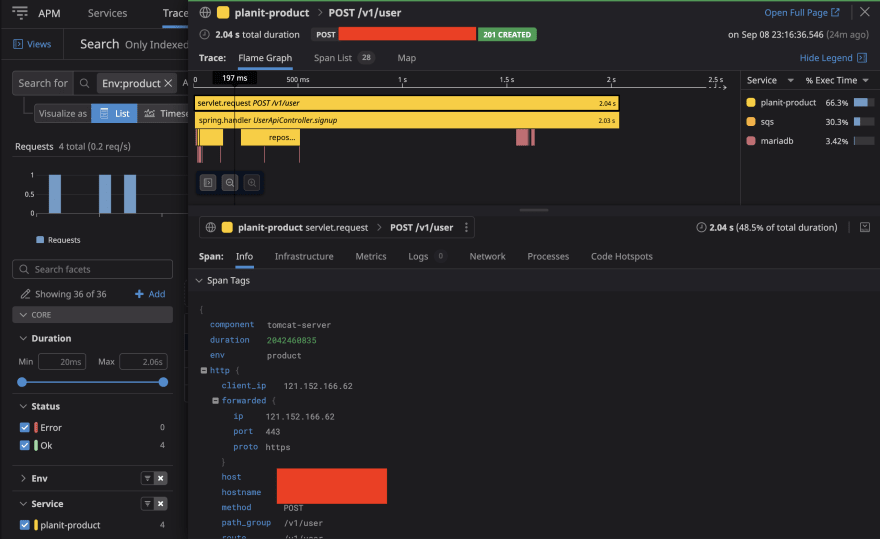By Roy Ra.Oct 06, 2022
In this post, I will go through the steps required to integrate Datadog APM with EKS using Fargate as computing option.
The process is very similar to Setting up Datadog APM on ECS, Fargate(Spring Boot).
The datadog agent container must run as a sidecar of each of your application’s container.
Installing datadog agent
We will use helm to install datadog agent into Kubernetes cluster.
First, run the command below to add datadog’s repository to helm.
helm repo add datadog https://helm.datadoghq.com helm repo update
After that, we have to edit values.yaml file, which will be used as a configuration file used by datadog agent running in the cluster. The fields I overrided(edited) are as below.
registry: Apply the value of AWS in the comment.datadog.apiKey: Value of the API key that you created in Datadog.datadog.apm.portEnabled: Set to true.
Finally, let’s run the command below to finish installation.
helm install datadog-agent -f values.yaml datadog/datadog
Configuring APM
To integrate Datadog APM with your application, you must make sure that your application uses datadog agent when running itself. For instance, I have a Spring boot application (JVM), and corresponding dockerfile looks as below.
There is 1 datadog agent installed on your EKS cluster, and another datadog agent running as a process of your application to collect metrics.
FROM openjdk:11-jdk AS builder
WORKDIR application
ARG JAR_FILE=build/libs/MY_APP.jar
COPY ${JAR_FILE} application.jar
RUN java -Djarmode=layertools -jar application.jar extract
FROM openjdk:11-jdk
WORKDIR application
RUN apt-get update \
&& apt-get install -y wget \
&& rm -rf /var/lib/apt/lists/*
RUN wget -O dd-java-agent.jar 'https://dtdg.co/latest-java-tracer'
COPY --from=builder application/application.jar ./application.jar
RUN true
COPY --from=builder application/dependencies/ ./
RUN true
COPY --from=builder application/spring-boot-loader/ ./
RUN true
COPY --from=builder application/snapshot-dependencies/ ./
RUN true
COPY --from=builder application/application/ ./
RUN true
ENV TZ Asia/Seoul
ENTRYPOINT ["java", "-javaagent:dd-java-agent.jar", "-Ddd.profiling.enabled=true", "-XX:FlightRecorderOptions=stackdepth=256", "org.springframework.boot.loader.JarLauncher"]
In the example above, dd-java-agent.jar uses port 8126 of container running datadog agent to send metrics to datadog.
Now all we have to do is to add another container spec to Kubernetes deployment file.
apiVersion: apps/v1
kind: Deployment
metadata:
name: planit-deployment
namespace: planit
labels:
app: planit
spec:
replicas: 3
revisionHistoryLimit: 2
selector:
matchLabels:
app: planit
template:
metadata:
labels:
app: planit
spec:
containers:
- name: "CONTAINER_NAME"
image: "YOUR_IMAGE_NAME"
imagePullPolicy: Always
ports:
- containerPort: 8080
protocol: TCP
- name: datadog-agent
image: datadog/agent:latest
ports:
- containerPort: 8126
name: traceport
protocol: TCP
env:
- name: DD_KUBERNETES_KUBELET_NODENAME
valueFrom:
fieldRef:
apiVersion: v1
fieldPath: spec.nodeName
- name: DD_API_KEY
valueFrom:
secretKeyRef:
name: datadog-secret
key: DD_API_KEY
- name: DD_SITE
valueFrom:
secretKeyRef:
name: datadog-secret
key: DD_SITE
- name: DD_EKS_FARGATE
valueFrom:
secretKeyRef:
name: datadog-secret
key: DD_EKS_FARGATE
- name: DD_APM_ENABLED
valueFrom:
secretKeyRef:
name: datadog-secret
key: DD_APM_ENABLED
- name: DD_ENV
valueFrom:
secretKeyRef:
name: datadog-secret
key: DD_ENV
- name: DD_SERVICE
valueFrom:
secretKeyRef:
name: datadog-secret
key: DD_SERVICE
- name: DD_VERSION
valueFrom:
secretKeyRef:
name: datadog-secret
key: DD_VERSION
- name: DD_PROFILING_ENABLED
valueFrom:
secretKeyRef:
name: datadog-secret
key: DD_PROFILING_ENABLED
- name: DD_APM_IGNORE_RESOURCES
valueFrom:
secretKeyRef:
name: datadog-secret
key: DD_APM_IGNORE_RESOURCES
- name: DD_LOGS_INJECTION
valueFrom:
secretKeyRef:
name: datadog-secret
key: DD_LOGS_INJECTION
datadog-secretis a Kubernetes secret object I created to store configuration values related to Datadog.
After deploying new Kubernetes deployment, you should be able to see APM working well as below.

The original article published on Dev.
